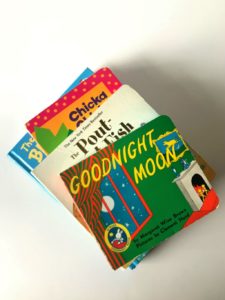 We’ve all been there. You ask your child to choose a book for reading time and she gives you that book. The one you’ve read aloud to her so many times that you now find yourself reciting the words at odd times during the day. “Don’t you want to read another story? Maybe the new book that Grandma got you?,” you ask. “No! This one!” is always the response. And so you settle in for another session of reading that same book while wondering if this means you can Marie Kondo the rest of the library.
We’ve all been there. You ask your child to choose a book for reading time and she gives you that book. The one you’ve read aloud to her so many times that you now find yourself reciting the words at odd times during the day. “Don’t you want to read another story? Maybe the new book that Grandma got you?,” you ask. “No! This one!” is always the response. And so you settle in for another session of reading that same book while wondering if this means you can Marie Kondo the rest of the library.
The good news? You’re not alone! The better news? Rereading is actually beneficial for kids.
Comprehension
The more times we engage with something, the better we understand it. Think about the times you’ve reread a book or re-watched a movie — odds are, you noticed different aspects of the story and understood more of the nuances the second, third, or fourth time around. Children are the same way, and rereading their favorite story gives them a way to pick up on new information in the text or illustrations, make stronger connections between the events in the story, or understand the deeper meaning and why characters reacted a certain way.
Vocabulary
As children get older and start to read harder books, they need a strong vocabulary to make sense of what they are reading. The best way to develop that vocabulary? That’s right — through rereading. In fact, a recent study found that children are more likely to retain knowledge of new vocabulary if they are exposed to the words through repeatedly reading the same book than if they encounter the new words in different books (Horst, Parsons, & Bryan, 2011). Each time your child rereads a book, he is internalizing those vocabulary words. To strengthen these connections even more, bring up the words in everyday conversation. And if the vocabulary in your child’s favorite book seems too simple? Don’t worry — more than likely it’s more complex and contains a greater variety of words than what she regularly hears in everyday conversation (how often do you really talk about kittens and mittens?). Plus, you can always choose a few items from the illustrations to talk about each time (e.g., the knitting needles, yarn, or striped curtains in Goodnight Moon).
Fluency
Fluency refers to the ability to read a text accurately at a conversational rate with expression. This is important because children who read fluently (as opposed to word by word) are more likely to understand what they are reading. Repeated readings help with fluency because as children get to know the words in a story, they are more likely to be able to read it with you. If your child isn’t reading with you yet, they can follow along by running their finger under the words as you read.
Confidence
As children reread a book, their expertise in the above areas increases their confidence. They are better able to follow along, read, and answer questions about the story, allowing them to feel successful about reading and more likely to enjoy it.
Knowing the benefits of rereading may not make it any easier to read your child’s favorite book for the hundredth time, but at least you’ll know that you’re helping him develop into a confident reader!













